Blog
How to Manage Ankle Sprains
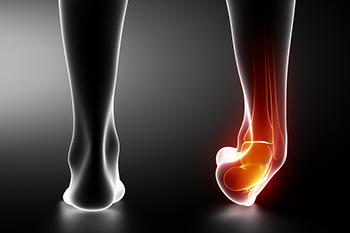 Ankle sprains occur when the ligaments that support the ankle stretch or tear, often due to sudden twisting, turning, or rolling of the foot. They are common in sports and activities that involve quick changes in direction. Symptoms can include pain, swelling, bruising, and difficulty walking or bearing weight on the affected ankle. Severe sprains may also cause instability and a popping sensation at the time of injury. Complications can include chronic ankle pain, instability, and arthritis if not properly treated. Treatment generally involves rest, compression, elevation, and anti-inflammatory medications to help manage the pain and swelling. Targeted stretching exercises are important for restoring strength and flexibility. Recovery time varies depending on the severity of the sprain but usually takes several weeks to a few months for full strength to return. If you believe you have sprained your ankle, it is suggested that you schedule an appointment with a podiatrist for a proper diagnosis and treatment.
Ankle sprains occur when the ligaments that support the ankle stretch or tear, often due to sudden twisting, turning, or rolling of the foot. They are common in sports and activities that involve quick changes in direction. Symptoms can include pain, swelling, bruising, and difficulty walking or bearing weight on the affected ankle. Severe sprains may also cause instability and a popping sensation at the time of injury. Complications can include chronic ankle pain, instability, and arthritis if not properly treated. Treatment generally involves rest, compression, elevation, and anti-inflammatory medications to help manage the pain and swelling. Targeted stretching exercises are important for restoring strength and flexibility. Recovery time varies depending on the severity of the sprain but usually takes several weeks to a few months for full strength to return. If you believe you have sprained your ankle, it is suggested that you schedule an appointment with a podiatrist for a proper diagnosis and treatment.
Although ankle sprains are common, they aren’t always minor injuries. If you need your ankle injury looked at, contact one of our podiatrists from James Kutchback, DPM, CWS-P. Our doctors can provide the care you need to keep you pain-free and on your feet.
How Does an Ankle Sprain Occur?
Ankle sprains are the result of a tear in the ligaments within the ankle. These injuries may happen when you make a rapid shifting movement while your foot is planted. A less common way to sprain your ankle is when your ankle rolls inward while your foot turns outward.
What Are the Symptoms?
- Pain at the sight of the tear
- Bruising/Swelling
- Ankle area is tender to touch
- In severe cases, may hear/feel something tear
- Skin discoloration
Preventing a Sprain
- Wearing appropriate shoes for the occasion
- Stretching before exercises and sports
- Knowing your limits
Treatment of a Sprain
In many cases, the RICE method (Rest, Ice, Compression, and Elevate) is used to treat ankle sprains. However, you should see a podiatrist to see which treatment option would work best with your injury. In severe cases, surgery may be required.
It is important to ask your doctor about rehab options after you receive treatment for your injury. Stretching, strength training, and balance exercises may help the ankle heal while also preventing further injury.
If you have any questions, please feel free to contact our offices located in The Woodlands and Woodville, TX . We offer the newest diagnostic and treatment technologies for all your foot care needs.
Plantar Fibromas and Nonsurgical Relief Options
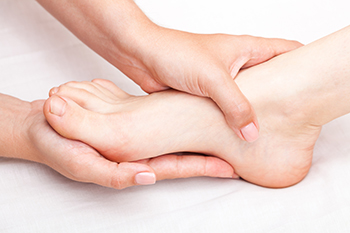
A plantar fibroma is a benign, fibrous knot embedded in the plantar fascia, the tissue along the bottom of the foot. This condition often causes a noticeable lump in the arch of the foot, leading to discomfort or pain when walking or standing. Nonsurgical relief options for plantar fibromas focus on reducing symptoms and improving foot function. Orthotic devices such as shoe inserts can help by distributing pressure more evenly across the foot and reducing strain on the plantar fascia. Stretching exercises and massage can alleviate tension and improve flexibility in the foot. Additionally, corticosteroid injections may be administered to reduce inflammation and pain associated with the fibroma. If you have developed a knot in the arch of your foot, it is suggested that you speak with a podiatrist who can determine what the best course of treatment is for you.
A plantar fibroma may disrupt your daily activities. If you have any concerns, contact one of our podiatrists of James Kutchback, DPM, CWS-P. Our doctors can provide the care you need to keep you pain-free and on your feet.
Plantar Fibroma
A plantar fibroma is a fibrous knot in the arch of the foot. It is embedded in the plantar fascia which is a band of tissue that extends from the heel to the toes along the bottom of the foot. There can be multiple plantar fibromas in the feet at the same time. There are no known causes for this condition. If you have a plantar fibroma, there will be a bump in the arch of your foot that cannot be missed. Any associated pain is most often due to a shoe rubbing against the nodule. Non-surgical options, such as steroid injections, physical therapy, and orthotics should be tried first. Surgery is a last resort and is the only thing that will remove a plantar fibroma entirely. Consult with a podiatrist for a proper diagnosis and to determine the treatment regimen that is right for you.
What Causes a Plantar Fibroma?
While there are no specific causes identified, a plantar fibroma can possibly come from genetic predisposition or the formation of scar tissue that forms from healing the tears in the plantar fascia.
What Are the Symptoms of a Plantar Fibroma?
There will be a noticeable lump in the arch of the foot that may or may not cause pain. If pain is felt, it is typically because a shoe is rubbing up against the lump or when walking or standing barefoot.
Treatment and Prevention
A plantar fibroma will not disappear without treatment, but it can get smaller and be a non-issue. If pain persists, a podiatrist examines the foot and when the arch of the foot is pressed, pain can be felt down to the toes. An MRI or biopsy might be performed to help diagnose or evaluate the plantar fibroma. The following non-surgical options are generally enough to reduce the size and pain of these nodules:
- Steroid injections
- Orthotics
- Physical therapy to help apply anti-inflammatory creams on the bump
Surgery is considered if the mass increases in size and the patient continues to feel pain after non-surgical methods are tried.
If you have any questions, please feel free to contact our offices located in The Woodlands and Woodville, TX . We offer the newest diagnostic and treatment technologies for all your foot care needs.
Causes and Diagnosis of Peripheral Artery Disease

Peripheral artery disease, or PAD, poses significant challenges for foot health, stemming from restricted blood flow to the lower extremities. This condition, often caused by atherosclerosis, involves the buildup of fatty deposits in the arteries, leading to narrowed or blocked blood vessels. The diminished blood supply to the feet can result in various symptoms, including pain, cramping, numbness, and weakness, particularly during physical activity. Left untreated, PAD can contribute to serious complications such as foot ulcers, infections, and delayed wound healing. Diagnosing PAD typically involves a comprehensive evaluation by a podiatrist. This process includes a thorough medical history review, assessment of risk factors such as smoking and diabetes, and a physical examination focused on evaluating circulation in the legs and feet. Specialized diagnostic tests, such as ankle-brachial index, or ABI measurement, Doppler ultrasound, and angiography, may also be employed to confirm the diagnosis and determine the extent of arterial blockages. If you are experiencing any of the foot symptoms mentioned above, it is suggested that you consult a podiatrist who can accurately diagnose and offer relief solutions for PAD.
Peripheral artery disease can pose a serious risk to your health. It can increase the risk of stroke and heart attack. If you have symptoms of peripheral artery disease, consult with one of our podiatrists from James Kutchback, DPM, CWS-P. Our doctors will assess your condition and provide you with quality foot and ankle treatment.
Peripheral artery disease (PAD) is when arteries are constricted due to plaque (fatty deposits) build-up. This results in less blood flow to the legs and other extremities. The main cause of PAD is atherosclerosis, in which plaque builds up in the arteries.
Symptoms
Symptoms of PAD include:
- Claudication (leg pain from walking)
- Numbness in legs
- Decrease in growth of leg hair and toenails
- Paleness of the skin
- Erectile dysfunction
- Sores and wounds on legs and feet that won’t heal
- Coldness in one leg
It is important to note that a majority of individuals never show any symptoms of PAD.
Diagnosis
While PAD occurs in the legs and arteries, Podiatrists can diagnose PAD. Podiatrists utilize a test called an ankle-brachial index (ABI). An ABI test compares blood pressure in your arm to you ankle to see if any abnormality occurs. Ultrasound and imaging devices may also be used.
Treatment
Fortunately, lifestyle changes such as maintaining a healthy diet, exercising, managing cholesterol and blood sugar levels, and quitting smoking, can all treat PAD. Medications that prevent clots from occurring can be prescribed. Finally, in some cases, surgery may be recommended.
If you have any questions, please feel free to contact our offices located in The Woodlands and Woodville, TX . We offer the newest diagnostic and treatment technologies for all your foot care needs.
Poor Circulation in Your Feet
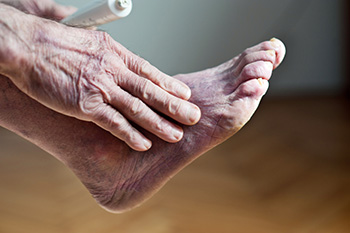 Are your feet frequently cold or numb? If so, you may be experiencing poor circulation, a condition that affects blood flow to the feet. Poor circulation can lead to a range of uncomfortable symptoms, including cold feet, numbness, tingling sensations, and sometimes slowly healing wounds. This condition is often caused by underlying health issues such as diabetes, peripheral artery disease, or vascular problems. Ignoring poor circulation can lead to serious complications, including tissue damage and infections. Don't let poor circulation hold you back from enjoying life. If you are experiencing poor circulation in your feet, it is suggested that you schedule an appointment with a podiatrist to discuss treatment options and prevent any further complications or discomfort.
Are your feet frequently cold or numb? If so, you may be experiencing poor circulation, a condition that affects blood flow to the feet. Poor circulation can lead to a range of uncomfortable symptoms, including cold feet, numbness, tingling sensations, and sometimes slowly healing wounds. This condition is often caused by underlying health issues such as diabetes, peripheral artery disease, or vascular problems. Ignoring poor circulation can lead to serious complications, including tissue damage and infections. Don't let poor circulation hold you back from enjoying life. If you are experiencing poor circulation in your feet, it is suggested that you schedule an appointment with a podiatrist to discuss treatment options and prevent any further complications or discomfort.
While poor circulation itself isn’t a condition; it is a symptom of another underlying health condition you may have. If you have any concerns with poor circulation in your feet contact one of our podiatrists of James Kutchback, DPM, CWS-P. Our doctors will treat your foot and ankle needs.
Poor Circulation in the Feet
Peripheral artery disease (PAD) can potentially lead to poor circulation in the lower extremities. PAD is a condition that causes the blood vessels and arteries to narrow. In a linked condition called atherosclerosis, the arteries stiffen up due to a buildup of plaque in the arteries and blood vessels. These two conditions can cause a decrease in the amount of blood that flows to your extremities, therefore resulting in pain.
Symptoms
Some of the most common symptoms of poor circulation are:
- Numbness
- Tingling
- Throbbing or stinging pain in limbs
- Pain
- Muscle Cramps
Treatment for poor circulation often depends on the underlying condition that causes it. Methods for treatment may include insulin for diabetes, special exercise programs, surgery for varicose veins, or compression socks for swollen legs.
As always, see a podiatrist as he or she will assist in finding a regimen that suits you. A podiatrist can also prescribe you any needed medication.
If you have any questions, please feel free to contact our offices located in The Woodlands and Woodville, TX . We offer the newest diagnostic and treatment technologies for all your foot care needs.
Surgical Excision of a Plantar Fibroma

Plantar fibromas are benign growths that develop in the arch of the foot, often causing discomfort and difficulty with walking. When conservative treatments fail to provide relief, foot surgery may be necessary to alleviate symptoms and restore mobility. During the procedure, the patient is typically placed under local anesthesia, numbing the foot to minimize pain. The surgeon then makes an incision in the skin, carefully dissecting the fibroma from surrounding tissues and nerves. Once the fibroma is removed, the incision is closed with sutures, and a dressing is applied to promote healing. Recovery time varies, depending on the size of the fibroma and the individual's ability to heal, but most patients can expect to resume normal activities within a few weeks. While surgical plantar fibroma excision offers a permanent solution, it is essential to discuss the risks and benefits with a podiatrist. If you have a plantar fibroma that is causing you pain, it is suggested that you make an appointment with a podiatrist who can determine if this surgery is right for you.
Foot surgery is sometimes necessary to treat a foot ailment. To learn more, contact one of our podiatrists of James Kutchback, DPM, CWS-P. Our doctors will assist you with all of your foot and ankle needs.
When Is Surgery Necessary?
Foot and ankle surgery is generally reserved for cases in which less invasive, conservative procedures have failed to alleviate the problem. Some of the cases in which surgery may be necessary include:
- Removing foot deformities like bunions and bone spurs
- Severe arthritis that has caused bone issues
- Cosmetic reconstruction
What Types of Surgery Are There?
The type of surgery you receive will depend on the nature of the problem you have. Some of the possible surgeries include:
- Bunionectomy for painful bunions
- Surgical fusion for realignment of bones
- Neuropathy decompression surgery to treat nerve damage
Benefits of Surgery
Although surgery is usually a last resort, it can provide more complete pain relief compared to non-surgical methods and may allow you to finally resume full activity.
Surgical techniques have also become increasingly sophisticated. Techniques like endoscopic surgery allow for smaller incisions and faster recovery times.
If you have any questions, please feel free to contact our offices located in The Woodlands and Woodville, TX . We offer the newest diagnostic and treatment technologies for all your foot care needs.
Children's Feet From Pre-Crawling to School Age

Children's feet undergo remarkable changes and developments as they progress through various stages of infancy and early childhood. In the pre-crawling stage, babies' feet are flexible and mostly fat pads, allowing them to kick and wiggle freely. As they transition to crawling, their feet adapt to bearing weight, developing arches and strengthening muscles necessary for mobility. Throughout the toddler years, a child's feet continue to evolve, with walking and running becoming primary modes of transportation. During this stage, proper footwear becomes vital to support their growing feet and provide stability. By the time children enter kindergarten and beyond, their feet have typically developed arches, and they exhibit more refined coordination and balance. As they engage in more physical activities and sports, maintaining foot health through wearing well-fitted shoes, regular exercise, and proper hygiene becomes essential. If you have any questions about the development of your child’s feet or what type of shoes to purchase, it is suggested that you consult a podiatrist who can address them.
Making sure that your children maintain good foot health is very important as they grow. If you have any questions, contact one of our podiatrists of James Kutchback, DPM, CWS-P. Our doctors can provide the care you need to keep you pain-free and on your feet.
Keeping Children's Feet Healthy
Having healthy feet during childhood can help prevent medical problems later in life, namely in the back and legs. As children grow, their feet require different types of care. Here are some things to consider...
Although babies do not walk yet, it is still very important to take care of their feet.
Avoid putting tight shoes or socks on his or her feet.
Allow the baby to stretch and kick his or her feet to feel comfortable.
As a toddler, kids are now on the move and begin to develop differently. At this age, toddlers are getting a feel for walking, so don’t be alarmed if your toddler is unsteady or ‘walks funny’.
As your child gets older, it is important to teach them how to take care of their feet.
Show them proper hygiene to prevent infections such as fungus.
Be watchful for any pain or injury.
Have all injuries checked by a doctor as soon as possible.
Comfortable, protective shoes should always be worn, especially at play.
If you have any questions, please feel free to contact our offices located in The Woodlands and Woodville, TX . We offer the newest diagnostic and treatment technologies for all your foot care needs.
How Heel Pain Can Be Treated
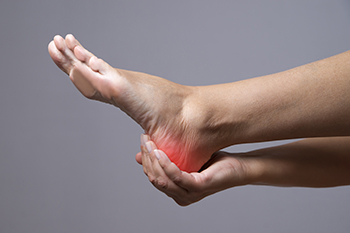
Heel pain, a common foot ailment, can disrupt daily activities and signal underlying issues. Typically stemming from conditions like plantar fasciitis, Achilles tendonitis, or heel spurs, it manifests as discomfort or tenderness beneath or behind the heel. Treatment often involves a combination of conservative measures, such as rest, stretching exercises, custom orthotic inserts, and supportive footwear to alleviate symptoms and promote healing. In some cases, nonsteroidal anti-inflammatory drugs or corticosteroid injections may be recommended for pain relief. However, if left unaddressed, heel pain can lead to chronic discomfort, mobility limitations, and even changes in gait. Additionally, persistent heel pain may indicate more serious conditions that require specialized intervention. If you have persistent or worsening heel pain, it is suggested that you schedule an appointment with a podiatrist for an individualized treatment plan that can expedite recovery and prevent complications.
Many people suffer from bouts of heel pain. For more information, contact one of our podiatrists of James Kutchback, DPM, CWS-P. Our doctors can provide the care you need to keep you pain-free and on your feet.
Causes of Heel Pain
Heel pain is often associated with plantar fasciitis. The plantar fascia is a band of tissues that extends along the bottom of the foot. A rip or tear in this ligament can cause inflammation of the tissue.
Achilles tendonitis is another cause of heel pain. Inflammation of the Achilles tendon will cause pain from fractures and muscle tearing. Lack of flexibility is also another symptom.
Heel spurs are another cause of pain. When the tissues of the plantar fascia undergo a great deal of stress, it can lead to ligament separation from the heel bone, causing heel spurs.
Why Might Heel Pain Occur?
- Wearing ill-fitting shoes
- Wearing non-supportive shoes
- Weight change
- Excessive running
Treatments
Heel pain should be treated as soon as possible for immediate results. Keeping your feet in a stress-free environment will help. If you suffer from Achilles tendonitis or plantar fasciitis, applying ice will reduce the swelling. Stretching before an exercise like running will help the muscles. Using all these tips will help make heel pain a condition of the past.
If you have any questions, please feel free to contact our offices located in The Woodlands and Woodville, TX . We offer the newest diagnostic and treatment technologies for all your foot care needs.
Symptoms of Toenail Fungus
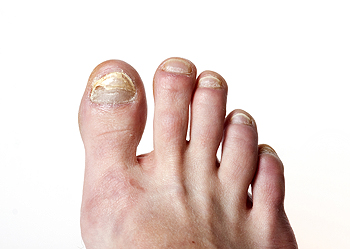 Toenail fungus, also known as onychomycosis, has several distinct symptoms that can affect the appearance and health of your toenails. The infection usually starts with a white or yellow spot under the tip of the toenail. As it progresses, the fungus can cause the nail to discolor, thicken, and develop crumbling edges. This may make the nail difficult to trim. The affected nails may also become brittle, ragged, and take on a dull, lackluster appearance. In some cases, the nail can separate from the nail bed. This may be a painful experience and can lead to further complications. Advanced cases of toenail fungus can result in a foul odor. A podiatrist, or foot doctor, can recommend effective treatments. These often include antifungal medications, topical treatments, and, in severe instances, professional removal of the nail. If you suspect toenail fungus, it is suggested that you schedule an appointment with a podiatrist to discuss treatment options.
Toenail fungus, also known as onychomycosis, has several distinct symptoms that can affect the appearance and health of your toenails. The infection usually starts with a white or yellow spot under the tip of the toenail. As it progresses, the fungus can cause the nail to discolor, thicken, and develop crumbling edges. This may make the nail difficult to trim. The affected nails may also become brittle, ragged, and take on a dull, lackluster appearance. In some cases, the nail can separate from the nail bed. This may be a painful experience and can lead to further complications. Advanced cases of toenail fungus can result in a foul odor. A podiatrist, or foot doctor, can recommend effective treatments. These often include antifungal medications, topical treatments, and, in severe instances, professional removal of the nail. If you suspect toenail fungus, it is suggested that you schedule an appointment with a podiatrist to discuss treatment options.
If left untreated, toenail fungus may spread to other toenails, skin, or even fingernails. If you suspect you have toenail fungus it is important to seek treatment right away. For more information about treatment, contact one of our podiatrists of James Kutchback, DPM, CWS-P. Our doctors can provide the care you need to keep you pain-free and on your feet.
Symptoms
- Warped or oddly shaped nails
- Yellowish nails
- Loose/separated nail
- Buildup of bits and pieces of nail fragments under the nail
- Brittle, broken, thickened nail
Treatment
If self-care strategies and over-the-counter medications does not help your fungus, your podiatrist may give you a prescription drug instead. Even if you find relief from your toenail fungus symptoms, you may experience a repeat infection in the future.
Prevention
In order to prevent getting toenail fungus in the future, you should always make sure to wash your feet with soap and water. After washing, it is important to dry your feet thoroughly especially in between the toes. When trimming your toenails, be sure to trim straight across instead of in a rounded shape. It is crucial not to cover up discolored nails with nail polish because that will prevent your nail from being able to “breathe”.
In some cases, surgical procedure may be needed to remove the toenail fungus. Consult with your podiatrist about the best treatment options for your case of toenail fungus.
If you have any questions please contact our offices located in The Woodlands and Woodville, TX . We offer the newest diagnostic and treatment technologies for all your foot and ankle needs.





